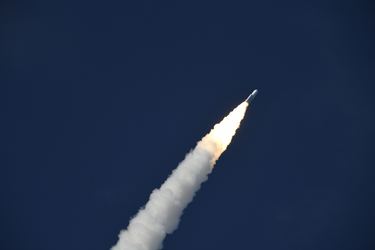Accept all cookies Accept only essential cookies See our Cookie Notice

About ESA
The European Space Agency (ESA) is Europe’s gateway to space. Its mission is to shape the development of Europe’s space capability and ensure that investment in space continues to deliver benefits to the citizens of Europe and the world.
Highlights
ESA - United space in Europe
This is ESA ESA facts Member States & Cooperating States Funding Director General Top management For Member State Delegations European vision European Space Policy ESA & EU Space Councils Responsibility & Sustainability Annual Report Calendar of meetings Corporate newsEstablishments & sites
ESA Headquarters ESA ESTEC ESA ESOC ESA ESRIN ESA EAC ESA ESAC Europe's Spaceport ESA ESEC ESA ECSAT Brussels Office Washington OfficeWorking with ESA
Business with ESA ESA Commercialisation Gateway Law at ESA Careers Cyber resilience at ESA IT at ESA Newsroom Partnerships Merchandising Licence Education Open Space Innovation Platform Integrity and Reporting Administrative Tribunal Health and SafetyMore about ESA
History ESA Historical Archives Exhibitions Publications Art & Culture ESA Merchandise Kids Diversity ESA Brand Centre ESA ChampionsLatest
Space in Member States
Find out more about space activities in our 23 Member States, and understand how ESA works together with their national agencies, institutions and organisations.
Science & Exploration
Exploring our Solar System and unlocking the secrets of the Universe
Go to topicAstronauts
Missions
Juice Euclid Webb Solar Orbiter BepiColombo Gaia ExoMars Cheops Exoplanet missions More missionsActivities
International Space Station Orion service module Gateway Concordia Caves & Pangaea BenefitsLatest
Space Safety
Protecting life and infrastructure on Earth and in orbit
Go to topicAsteroids
Asteroids and Planetary Defence Asteroid danger explained Flyeye telescope: asteroid detection Hera mission: asteroid deflection Near-Earth Object Coordination CentreSpace junk
About space debris Space debris by the numbers Space Environment Report In space refuelling, refurbishing and removingSafety from space
Clean Space ecodesign Zero Debris Technologies Space for Earth Supporting Sustainable DevelopmentLatest
Applications
Using space to benefit citizens and meet future challenges on Earth
Go to topicObserving the Earth
Observing the Earth Future EO Copernicus Meteorology Space for our climate Satellite missionsCommercialisation
ESA Commercialisation Gateway Open Space Innovation Platform Business Incubation ESA Space SolutionsLatest
Enabling & Support
Making space accessible and developing the technologies for the future
Go to topicBuilding missions
Space Engineering and Technology Test centre Laboratories Concurrent Design Facility Preparing for the future Shaping the Future Discovery and Preparation Advanced Concepts TeamSpace transportation
Space Transportation Ariane Vega Space Rider Future space transportation Boost! Europe's Spaceport Launches from Europe's Spaceport from 2012Latest

To space! But on which rocket?
Thank you for liking
You have already liked this page, you can only like it once!
Teams at Mission Control match the needs of ESA missions with the perfect rocket. The choice of rocket depends primarily on the mass of the payload and where it needs to go.
The further from Earth a spacecraft needs to be lifted, and the more massive it is, the more fuel that is needed.
To the Moon and beyond
The minimum velocity required to get beyond Earth’s gravitational sphere of influence is 11.2 km per second, after which point spacecraft engines and planetary flybys are used to reach deep space destinations.
The mighty Ariane 64 can accelerate 6900 kg (or a large orca) to this important speed.
To geostationary transfer orbit
Most communication and weather satellites live about 36 000 km above Earth’s equator in geostationary orbit - from where they appear to hover unmoving above our heads.
The Ariane 62 can lift 5000 kg (or an Asian elephant) to the geostationary transfer orbit, and the Ariane 64, 11 500 kg (or a whale shark), from where spacecraft boost themselves into geostationary orbit.
Orbiting near Earth
Most human-made objects in space reside in low-Earth orbit, from 100 km to 2000 km above Earth’s surface.
The nimble Vega-C can carry 2250 kg (or a hippopotamus) to this crowded zone, while the Ariane 62 can lift up to 10 300 kg (or an African elephant) and the mighty Ariane 64 a whopping 21 600 kg (or a small grey whale).
-
CREDIT
ESA -
LICENCE
ESA Standard Licence

Ariane 5 takes MTG-I1 into orbit

Ariane 6 launch complex processing

Fairing inspection

The Ariane launcher family artist's view















 Germany
Germany
 Austria
Austria
 Belgium
Belgium
 Denmark
Denmark
 Spain
Spain
 Estonia
Estonia
 Finland
Finland
 France
France
 Greece
Greece
 Hungary
Hungary
 Ireland
Ireland
 Italy
Italy
 Luxembourg
Luxembourg
 Norway
Norway
 The Netherlands
The Netherlands
 Poland
Poland
 Portugal
Portugal
 Czechia
Czechia
 Romania
Romania
 United Kingdom
United Kingdom
 Slovenia
Slovenia
 Sweden
Sweden
 Switzerland
Switzerland
























